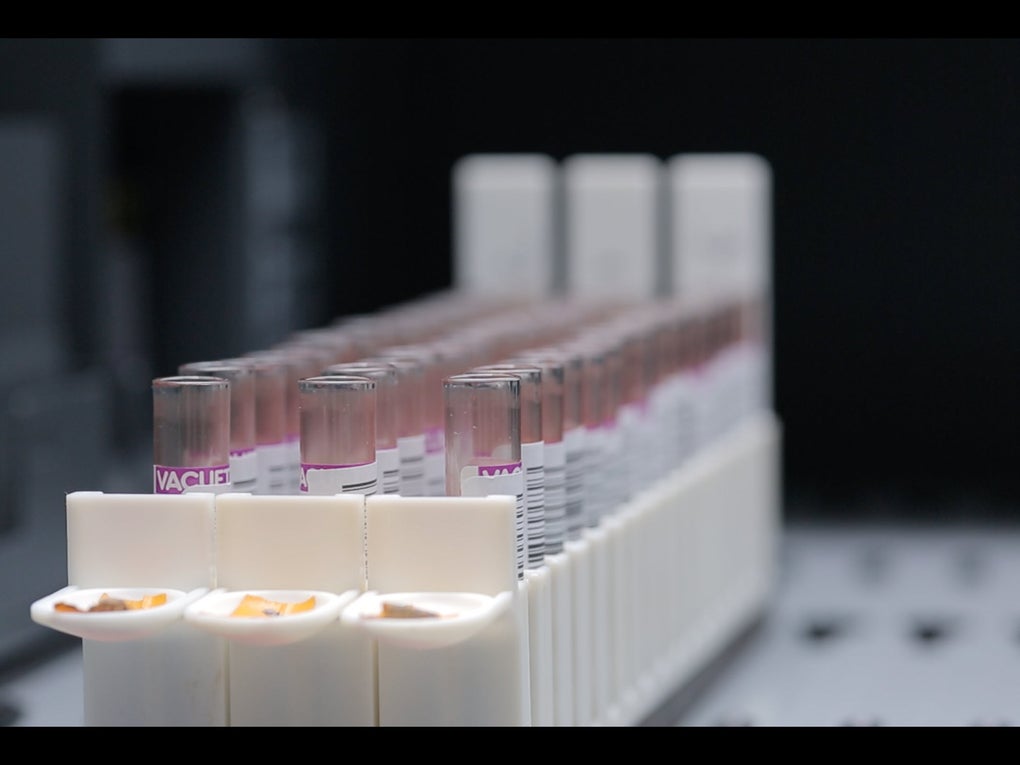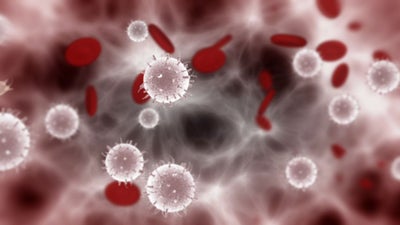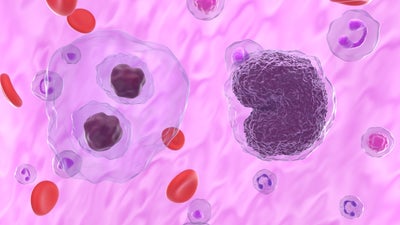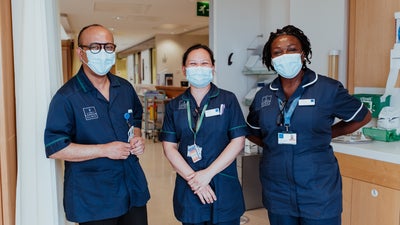
Blood cancers and blood disorders: diagnostic tests
If you have a blood cancer or a blood disorder, your doctor can often get an initial understanding from a blood test. However, to achieve a complete and accurate diagnosis, you are likely to need additional tests.
X-ray
Most people are familiar with x-rays and may have had one themselves. X-rays are a type of high-energy radiation that can pass painlessly through the body. Radiographers use a very small dose of x-ray radiation to produce images of the inside of your body.
When used appropriately, x-rays are generally safe. Depending on the type of x-ray, the radiation dose can be similar to a few days’ worth of natural background radiation, though this can vary.
X-rays are not particularly effective at showing soft tissues, which may appear faint or indistinct. However, bones are clearly visible because they absorb more x-rays. You might undergo an x-ray if you have bone pain or to rule out or diagnose a fracture, which can occur with conditions like myeloma.
Having your X-ray
You usually don’t need to do anything special to prepare for an x-ray. However, it’s advisable to avoid wearing clothing without metal components such as zippers, buckles, or buttons, as these can interfere with the x-ray image and may need to be removed.
CT scan
CT stands for computed tomography, previously known as CAT (computed axial tomography) scans. A CT scanner takes a series of cross-sectional, x-ray images from multiple angles around your body, which are then compiled by a computer to create a detailed image. These images provide much more detail than a standard x-ray.
Because a CT scan involves multiple x-ray images, it exposes you to more radiation than a single x-ray. The amount of radiation can vary depending on the type and extent of the scan, roughly equivalent to a few months to several years of natural background radiation.
CT scans are particularly useful for visualising soft tissues that are not as clearly seen on plain x-rays. They are commonly used for diagnosing various conditions, monitoring disease progression, or assessing the effectiveness of treatments.
Having your scan
The CT scanner is shaped like a large, circular doughnut standing upright. You will lie on a bed that moves slowly in and out of the scanner as images are taken. The procedure is completely painless and typically takes less than 30 minutes.
Preparation for a CT scan is generally minimal, but you may be asked to avoid wearing clothing with metal fasteners, as these can interfere with the images. For some scans, you might receive an injection of a contrast agent, usually iodine-based, which helps highlight specific tissues or blood vessels. Your healthcare provider will give you specific instructions if any preparation is needed.
PET scan
PET stands for positron emission tomography. A positron is a subatomic particle similar to an electron but with a positive charge. Unlike other types of scans that show structural details, PET scans reveal metabolic activity in body tissues. Before the scan, you receive an injection of a radionuclide, which consists of radioactive atoms attached to molecules that your body naturally uses. These molecules accumulate in specific tissues, and the radioactive atoms emit signals that the scanner detects to create an image.
The type of molecule used depends on what your doctor needs to examine. For instance, PET scans often use a glucose-based molecule called fluorodeoxyglucose (FDG), resulting in an FDG-PET scan. Active tissues, such as cancer cells, consume more glucose, making them more visible on the scan. Other molecules can be used to assess different functions, like blood flow.
Preparing for your scan
You should avoid vigorous exercise for 24 hours before the scan and may need to fast for up to six hours beforehand; your hospital will provide specific instructions. It’s also advisable to avoid wearing metal, as it may interfere with the scan, particularly if the PET is combined with a CT scan.
On the day of the scan, punctuality is crucial because the radionuclide injection decays quickly. If you’re late, the scan might need to be rescheduled.
After changing into a gown, if necessary, you’ll receive the radionuclide injection into a vein, typically in your hand or arm. You'll then rest quietly for about an hour to allow the radionuclide to distribute throughout your body. During the scan, you’ll lie on a bed that moves into a cylindrical scanner. The process usually takes between 30 minutes and an hour.
The radiation exposure from a PET scan is minimal, making it a safe procedure. However, to ensure safety, you may be advised to avoid close contact with pregnant women, babies, and young children for a few hours after the scan. Drinking plenty of fluids can help flush the radioactive material from your body more quickly.
PET-CT scans
A PET-CT scan combines a CT scan with a PET scan, providing detailed images that show both the structure and metabolic activity of body tissues.
Because a PET-CT scan involves both types of imaging, it exposes you to more radiation than either scan alone. However, your doctor will recommend this test only if the benefits outweigh the risks, ensuring a more accurate diagnosis and appropriate treatment. For a whole-body PET-CT scan, the radiation dose is roughly equivalent to the amount of natural background radiation you would receive over two to eight years.
Preparing for your scan
The preparation and procedure for a PET-CT scan are similar to those for a PET scan.
MRI scan
Unlike CT and PET scans, MRI scans use magnetic fields rather than radiation to produce detailed images. The process is complex, involving the behaviour of hydrogen protons within the body.
MRI scanners take advantage of the fact that protons in hydrogen atoms are sensitive to magnetic fields. When exposed to a strong magnetic field, these protons align in a specific direction. During the scan, bursts of radiofrequency waves disrupt this alignment. When the radio waves are turned off the protons realign, emitting signals that the scanner detects. Different tissues emit different signals and take varying times to realign. The MRI scanner compiles these signals to create images of the body's interior.
To undergo an MRI, it’s crucial that you don’t have any metal on or in your body. Some individuals cannot have MRI scans due to metal implants like pacemakers. However, certain implants are designed to be MRI-safe. Always inform your doctor of any implants or the possibility of metal fragments in your body, especially from past injuries or metalworking. An X-ray may be used to check for such fragments, though it may not detect all types.
Before and during the scan
You can usually eat and drink as normal before an MRI scan. You’ll need to complete a safety questionnaire beforehand. If necessary, you might change into a gown, ensuring all metal items, including hearing aids and dentures, are removed.
While MRI scans are painless, some people find them challenging due to the noise and the enclosed space. If you are claustrophobic, inform your doctor when scheduling the scan. Sedatives can be provided if needed, but you’ll require someone to accompany you home if you take one.
For certain types of MRI scans, a contrast injection may be used to enhance image clarity, though it isn’t always required. During the scan, you’ll lie on a bed that slides into a tube-like scanner. To protect your hearing from the noise, earplugs or headphones are provided. Depending on the area being examined, an MRI can take between 15 and 90 minutes.
Ultrasound
Ultrasound scans use high-frequency sound waves that bounce off various body structures and are detected by an ultrasound probe. These sound waves are processed to create a real-time moving image. Ultrasounds are commonly used to examine internal organs, muscles, joints and blood flow.
Having your scan
In most cases, no special preparation is required for an ultrasound, but your hospital will inform you if any steps are necessary. For certain specialized ultrasounds, a contrast agent may be injected to enhance the visibility of tissues, though this is uncommon.
During the scan, a cold gel is applied to the area being examined to ensure good contact between the ultrasound probe and the skin. A trained sonographer or radiographer will then move the probe over the area, and the image will appear on a monitor in real-time. Ultrasound scans are painless and typically last between 15 and 30 minutes, though some may take up to 45 minutes.
Lymph node biopsy
A lymph node biopsy involves removing part or all of a lymph node to examine it under a microscope for abnormal cells. This is typically done through a minor surgical procedure.
How the biopsy is done
The procedure varies based on the location of the lymph node. You may receive local anaesthesia for less invasive biopsies, or general anaesthesia if the lymph node is in a deeper or less accessible area. The doctor will make a small incision in your skin, remove the lymph node, and then close the incision with stitches. The entire procedure usually takes between 30 minutes to an hour.
After the biopsy, a small dressing will cover the incision site. Your nurse will provide instructions on how to care for it. Some stitches may dissolve on their own, while others may need to be removed during a follow-up visit. You might experience some soreness or bruising, which typically resolves quickly. Over-the-counter painkillers can help manage any discomfort.
Bone marrow biopsy
This means taking a sample of bone marrow and looking at it under a microscope for signs of abnormal cells. You have this done under a local anaesthetic; children may have a general anaesthetic.
Having your bone marrow biopsy
The bone marrow sample is usually taken from your hip. Your doctor will ask you to lie on your side, with your knees drawn up. You have an injection of local anaesthetic, you may also have a sedative to make you drowsy while the biopsy is taken. Some people prefer this because they find the biopsy quite painful, however not everyone does; it is quite individual.
When the area is numb, the doctor will put a long needle into the hip bone and draw out some liquid bone marrow. This is sometimes called bone marrow aspiration. They may also use a trephine, an instrument like a very, very thin apple corer, to take out a piece of bone and more some solid marrow. You will have a dressing put over the area. The whole thing usually takes less than half an hour.
If you are having this test as an outpatient, you can usually go home as soon as you feel able. If you have had a sedative, you will need someone to take you home.
Your hip will feel sore and bruised for a few days after your biopsy. You can take painkillers if you need to. It may take up to two weeks before you get the results of the biopsy.
Gene testing
For certain types of blood cancers and blood disorders, your doctor may recommend gene testing on abnormal blood cells to aid in diagnosis. This testing can also provide valuable information about how the condition may progress and the most effective treatment options.
Having gene tests
Gene testing for blood-related conditions typically involves either a blood sample or a bone marrow sample. In some cases, a bone marrow biopsy might be required. Depending on the specific tests being conducted, results can take anywhere from a few days to several weeks to be available. These results are crucial in guiding the overall treatment strategy.
A blood cancer or a blood disorder diagnosis can feel overwhelming, but you're not alone. Partnering with DKMS can help you share your story and amplify our combined efforts to expand the stem cell registry, so do reach out to us. Together, we can create more hope and opportunities for people living with blood cancer.
References
CT scan. Are CT scans safe? NHS website.
Positron Emission Tomography (PET). Johns Hopkins Medicine.
PET scan. NHS website. Last reviewed March 2021.
PET scan. Are PET scans safe? NHS website.
Recommendations for cross-sectional imaging in cancer management (2nd edition). Radiation dose. Royal College of Radiologists.
Understanding radiation risk from imaging tests. American Cancer Society.
MRI scan. Overview. NHS website.
Yong-Ha, K, Manki C and Jae-Won K. Are titanium implants actually safe for magnetic resonance imaging examinations? Concerns about MRI in patients with titanium implants. Archives of Plastic Surgery, 46(1), pp96-7. Published January 2019.
MRI scan. Who can have one? NHS website.
Ultrasound scan. NHS website.
Blood cancer tests. Lymph node biopsy. Blood Cancer UK.
Blood cancer tests. Bone marrow biopsy. Blood Cancer UK.
FISH test. WebMD. Last reviewed October 2019.


